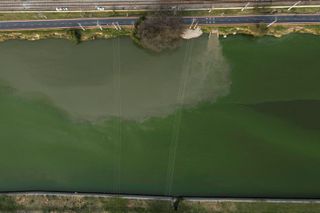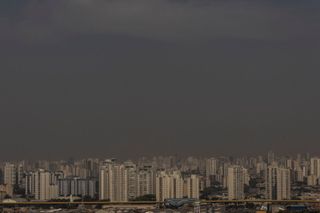South America is experiencing record-breaking fires, which have led to “black rain,” green rivers and dangerous air pollution of approx. 50 times higher more than the level recommended by the World Health Organization, according to air quality monitoring company IQair.
Between January 1 and September 16, the continent reported 364,485 forest firessurpassing the 2007 record of 345,322 fires, according to data from Brazilian Space Research Institute and Reuters.
The Amazon’s historic drought aggravated the spread of the fire. Many of the fires have been attributed to human activity, but the drought has created favorable conditions for their rapid spread. As a result, 60% of Brazil’s territory is currently affected by smog.
Including neighboring countries and the Atlantic Ocean, the area affected by the toxic cloud is now 4 million square kilometers – an area larger than the entire United States.
“The air quality in Brazil it never got worse,” Alessandra Fidelisa researcher at the Plant Ecology Laboratory of the State University of São Paulo, told Live Science.
Natalia Gilan atmospheric scientist and member of the Department of Air Quality and Smoke at the Department of Technological Laboratory of Uruguay, told Live Science that there has been a continuous decrease in air quality in the cities of southern Brazil, northern Argentina , Bolivia, Paraguay and northeastern Uruguay.
Related: The Sahara desert has been hit by a rare rain event that could spoil this year’s hurricane season.
In recent weeks, Gil has noticed “significant increases” in black carbon, particulate matter and gases such as ozone, nitrogen oxides and carbon monoxide in cities as far away as Buenos Aires, São Paulo, Londrina, Rio de Janeiro, Cochabamba and La. Paz. In Uruguay’s capital, Montevideo, residents have had poor visibility for several days due to a thick cloud of smoke and black rain – rain that turns dark due to a mixture of ash and smoke – reported in areas lots of land. The same situation happened everywhere 11 provinces of Argentinaincluding the Metropolitan Area of Buenos Aires.
Meanwhile, in São Paulo, the Pinheiros River turned emerald green due to an algae bloom caused by severe drought.

Paulo Saldivapathologist and professor at the University of São Paulo School of Medicine, compared the smoke produced by burning biomass to cigarette smoke, noting that both contain toxic substances that enter the body through the eyes, the way to breathe and breathe. For example, in a big city like São Paulo, the level of pollution from cars and industry is equivalent to smoking four to five cigarettes a day. However, for those exposed to long-term wildfire smoke, the effect is like “lighting one cigarette after another,” Saldiva said.
Environmental changes in recent decades, along with changes in land use, have significantly altered fire regimes. Although Brazil has always had periods of drought, the average number of consecutive days without rain has increased from 80 to 100 in the last decadeindicating the worsening of climate-related effects, Fidelis noted. “The forest can easily be burned, even with reduced deforestation rates,” Fidelis said.

In addition to changes in rainfall, rising temperatures, soil moisture and carbon dioxide levels can affect the timing, size, timing, frequency and intensity of fires. Luis López-Mársicoresearcher at the Institute of Ecology and Environmental Sciences at the University of the Republic of Uruguay, told Live Science.
In a large part of Brazil, these changes are manifested as higher temperatures, reduced rainfall and, above all, an increase in extreme drought events, which prolong the so-called “fire seasons”.
All of this creates a “new normal,” according to Fidelis. “We need to start realizing that we are dealing with a new issue that we once thought of as the future, but is now our reality: climate change,” he said.
#Recordbreaking #wildfires #engulfed #South #America #bringing #black #rain #green #rivers #toxic #air #continent